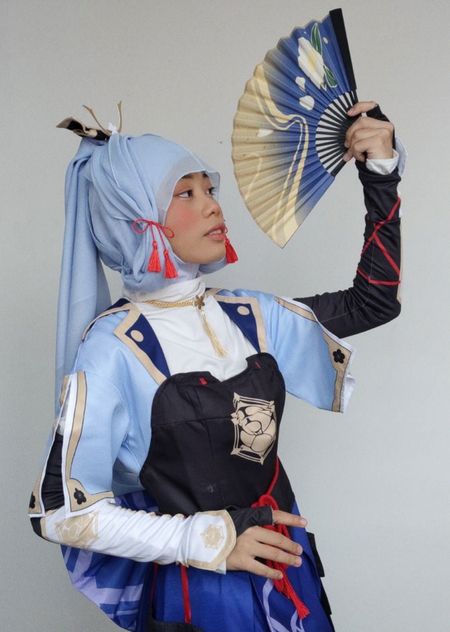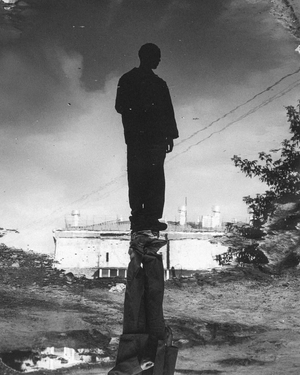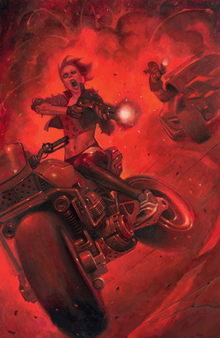
Hijab in teenage subcultures: modesty and creativity hand in hand
Terminology
Cosplay is a combination of the words «costume» and «play». It refers to the practice of dressing up as a character from a movie, television show, comic book, video game, or other form of media. It is often a social activity, with many enthusiasts participating in conventions, competitions, and online forums.
Cosplay grew in popularity in Japan during the 1980s and 1990s, especially with the rise of anime and manga culture. Events such as the Anime Expo in the United States began to emerge, providing platforms for cosplay enthusiasts to showcase their costumes. By the 2000s, cosplay had become a global phenomenon, spreading far beyond Japan.
«Muslims are strangers. We can’t fit into every single setting.»
Eventually, cosplay became popular in Muslim-majority countries such as Malaysia and Turkey.
Many young muslim men and women were interested in participating, wanting to incorporate and show their beliefs while doing their new hobby: «Hijab cosplay combines the elegance of modest fashion with the creativity of cosplay. One notable difference between hijab cosplay and traditional cosplay is the use of hijabs instead of wigs. The hijab, a garment worn by many Muslim women, is not only a beautiful symbol of modesty, but also a canvas for creative expression». © Mumu Alpaka
Many saw their beliefs not as a limitation, but as an opportunity to show the wider community the charming aesthetics of modesty and flowing fabrics. Hijab cosplay quickly attracted the interest of non-Muslims for its beautiful ornamentation and elegance, as well as other Muslim teens, who often say it makes them feel represented.
Cosplay is practiced by followers of the Sunni branch of Islam, and it’s not just wearing hijab, which is expected of youth, but modest, covering your ankles, neck, arms and shoulders. People also avoid cosplaying fictional deities, which clashes with their values.
History
Theater was not really widespread in early and medieval Islam. There were puppet shows and shadow plays, and very often the puppets had holes to show that they were not alive. Interest in drama and dance increased in the Ottoman Empire, influenced by European countries. Acting was still controversial at the beginning of the 20th century and was often shunned and persecuted.
However, in many Eastern countries that later adopted Islam as their main religion, there was a practice of theater and opera in pre-Islamic times, such as Bangsawan. These countries did not choose to forget their traditions, but to incorporate them into their new religion.
Even today, theater, acting, and the pursuit of hobbies often face prejudice.
«Ok, what is she gonna do? Which genre is she gonna play in that has no haram? How is she gonna have a stable career in such a non existing niche of television? Why would anyone take HER instead of plenty other, more talented people?»
«How is such a career proper for a Muslimah? What real world usefulness does she offer by pursuing this career?
Whole bunch of nonsense. Even as a non Muslim, becoming an actor is just crap. And as a Muslim, our standards are much higher than this toxic and haram acting environment.»
«What’s more likely is that she’ll be told to take off her hijab for better roles. She’ll also be the odd one out and stick out like a sore thumb in a typical theatre school setting, forget even getting into the industry. It’s just not realistic.»
Cosplay
Ayame Yuina as Fujiwara Chika from Kaguya-sama: Love is War!
Rainy Isabella as Kamisato Ayaka from Genshin Impact
Lovely Amizah as Springbloom Missive Kamisato Ayaka from Genshin impact
«The hijab made me who I am today. It has been my armour against the harsh world, it has kept me safe from bad company and from making bad decisions.» © Hijabi Hoo
A group cosplaying main characters from web animated show RWBY.
Hijabi Hoo as Captain America
Nico Rofy as Violet Evergarden
@ai_nurul_ and Nina as Hatsune Miku
«Thanks to God, there are also many who support hijab cosplay communities, both at home and abroad.» © Ange Minami
«Sometimes I think about how we can do our hobby while staying positive about it so that fellow cosplayers can express their creativity.» ©
@MiisaMHC as Gawr Gura from Hololive
Ai Nurul as Wednesday Addams from Wednesday the TV show
@shay.vanes as Raiden Shogun from Genshin Impact
Ange Minami as Mordred from Fate/Grand Order
Rainy Isabella as Sigewinne from Genshin Impact
Rainy Isabella as Mitsuri Kanroji from Demon Slayer
@queenofluna inspired by Junji Ito’s Uzumaki manga
@queenofluna as Queen Elsa from Frozen 2
J-Fashion
J-Fashion refers to a wide range of Japanese street fashion styles that emerged in the late 20th century. The term encompasses various subcultures and aesthetics that are heavily influenced by Japanese youth culture, anime, manga, and music. J-Fashion is known for its creativity, individualism, and the way it blends traditional Japanese elements with modern trends.
@ozz_sinjuku
@aliceberrybum
Chihaya Bibi @chibibie
@chibibie
Mori forest girl fashion @aliceberrybum
@aliceberrybum
Animation
One might wonder — if Muslim girls want to see representation in media, why don’t animated TV or comic book about muslim girls exist? Well, they do. For example, in 2018, a relatively short five-episode web-animated TV series titled «Emara,» «Hero of the Emirates».
«The story follows 19-year-old Moza as she delves undercover and transforms into superhero Emara. Clad in a navy blue headscarf, a green, white and gold costume, a cape lined with red, and golden specs inspired by the burqa (a traditional, metal-like cloth worn around the eyes by Emirati women), Emara fights crime on the busy, bustling streets of the UAE.» ©
However, the production of mass media today is big business, which requires huge production costs, which unfortunately can’t be fully and resonably covered by such a specific thin audience as teenage muslim girls.
Cover art of Season 1 (and only)
Moza, casually dressed, serves coffee in her family’s cafe
Emara fighting justice undercover
Maitha, Moza’s mother, comically and violently threatening to protect her daughter
Digital Art
On a smaller scale, we witness a vibrant community of creative individuals who are not only passionate about modern digital media, but also proud to wear the hijab.
Their contributions exemplify the dynamic and evolving nature of cultural expression, showing that being Muslim does not limit creativity, but enriches it.
Digital art by @art_ngapak
Digital art by Sara Alfageeh
Sara Alfageeh wearing a Hijab herself // Book covers Illustrated by her
Reception
In conclusion, hijab cosplay represents a unique intersection of culture, creativity, and personal expression. While some may hold misconceptions or criticize hijab cosplayers by viewing them through a narrow lens, many others celebrate them as pioneers who challenge stereotypes.
Hijab cosplay involves the promotion of inclusivity and diversity in fandom spaces, demonstrating that anyone can engage with popular culture, regardless of their background. It highlights the creativity of individuals who combine their cultural and religious identities with a passion for cosplay, demonstrating that Islam can indeed be modern, innovative, and accepting.
Concerns may arise from traditionalists who feel that cosplay detracts from the modesty associated with the hijab. However, this raises an important conversation about the interpretation of modesty and how it can coexist with modern creative expression.
Ultimately, hijab cosplayers are inspiring a new generation to embrace their identities while confidently participating in the broader cultural landscape, proving that tradition and content can go hand in hand.
«Wearing a hijab should not be a barrier for anything. We are free to be creative»
Hounaida El Jurdi, Mona Moufahim, Ofer Dekel «„They said we ruined the character and our religion“: authenticity and legitimation of hijab cosplay» https://www.emerald.com/insight/content/doi/10.1108/qmr-01-2021-0014/full/html
Yuddy Cahya, Ebrahim Harris «Hijab cosplay takes off as Muslim women embrace fan culture» https://www.reuters.com/article/world/hijab-cosplay-takes-off-as-muslim-women-embrace-fan-culture-idUSKBN1A603I/
Peter Chelkowski, «Islam in Modern Drama and Theatre»



